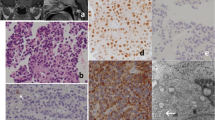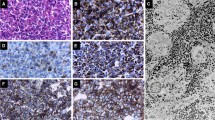Abstract
OBJECTIVE: The term “null cell” adenoma was first proposed in 1980 to designate pituitary adenomas lacking clinical, biochemical and morphological markers to disclose their cell origin. DESIGN: The aim of this study was to investigate the presence of α- and β-gonadotropin subunits in clinically nonfunctioning pituitary tumors, which were initially immunonegative and thus diagnosed as null cell adenomas. For this reason, we reapplied immunohistochemistry using a more sensitive method comprising a tyramide signal amplification technique, combined with a polymer antibody immunohistochemical detection system. RESULTS: With this approach, all these previously negative tumors became positive for α- and α-gonadotropin hormone subunits. CONCLUSIONS: Our results prove that so-called “null cell” adenomas produce α-SU or/and β-FSH or β-LH and therefore are gonadotrph adenomas in origin.
Similar content being viewed by others
References
Kovacs K, Ryan N, Horvath E, Ezrin C, 1980 Null cell adenoma of the human pituitary. Virchows Arch [A] Pathol Anat Histopathol 387: 165–174.
Kontogeorgos G, Kovacs K, Scheithauer BW, Rologis D, Orphanidis G, 1991 Alpha-subunit immunoreactivity in plurihormonal pituitary adenomas of acromegalic patients. Modern Pathol 4: 191–195.
Schultz S, Schultz S, Schmitt J, et al, 1998 Immunocytochemical detection of somatostatin receptors SST1, SST2A, SST2B and SST3 in paraffin-embedded breast cancer tissue using subtype-specific antibodies. Clin Cancer Res 4: 2047–2052.
Thodou E, Kontogeorgos G, Theodosiou D, Pateraki M, 2006 Mapping of somatostatin receptor types in GH or/and PRL producing pituitary adenomas. J Clin Pathol 59: 274–279.
Cooper O, Melmed S, 2012 Subclinical hyperfunctioning pituitary adenomas: The silent tumors. Best Pract Res Clin Endocrinol Metab 26: 447–460.
Asa SL 2007 Tumors of the Pituitary Gland. 4th Series — Atlas of Tumor Pathology. American Registry/Armed Forces Institute of Pathology: Washington, DC.
DeLellis RA, Heitz P, Lloyd RV, Eng C, (eds) 2007 WHO Classification of Tumours of the Endocrine Organs Pathology and Genetics of Endocrine Organs, IARC Press, Lyon.
Kontogeorgos G, Scheithauer BW, Kovacs K, Horvath E, 1993 Null cell adenomas, oncocytomas and gonadotroph adenomas of the human pituitary: An immunocytochemical and ultrastructural analysis of 300 cases. Endocr Pathol 4: 20–29.
Asa SL, Gerrie BM, Singer W, Horvath E, Kovacs K, Smyth HS, 1986 Gonadotropin secretion in vitro by human pituitary null cell adenomas and oncocytomas. J Clin Endocrinol Metab 62: 1011–1019.
Yamada S, Asa SL, Kovacs K, 1988 Oncocytomas and null cell adenomas of the human pituitary: Morphometry and in vitro functional comparison. Virchows Arch [A] Pathol Anat Histopathol 413: 333–339.
Yamada S, Asa SL, Kovacs K, Muller P, Smyth HS, 1989 Analysis of hormone secretion by clinically non functioning human pituitary adenomas using the reverse hemolytic plaque assay. J Clin Endocrinol Metab 66: 73–80.
Jameson JL, Klibanski A, Black PM, et al, 1987 Glycoprotein hormone genes are expressed in clinically nonfunctioning pituitary adenomas. J Clin Invest 80: 1472–1478.
Sakurai T, Seo H, Yamamoto N, et al, 1988 Detection of mRNA of prolactin and ACTH in clinically non-functioning adenomas. J Neurosurg 69: 653–659.
Baz E, Saeger W, Uhlig H, Fehr S, Ludecke DK, 1991 HGH, PRL and beta HCG/beta LH gene expression in clinically inactive pituitary adenomas detected by in situ hybridization. Virchows Arch [A] Pathol Anat Histopathol 418: 405–410.
Lloyd RV, Jin L, Fields K, et al, 1991 Analysis of pituitary hormones and chromogranin A mRNA in null cell adenomas, oncocytomas and gonadotroph adenomas by in situ hybridization. Am J Pathol 139: 553–556.
Schmid M, Münscher A, Saeger W, Schreiber S, Lüdecke DK, 2001 Pituitary hormone mRNA in null cell adenomas and oncocytomas by in situ hybridization comparison with immunohistochemical and clinical data. Pathol Res Pract 97: 663–669.
Trouillas J, Girod C, Sassolas G, Caustrat B, 1986 The human gonadotropic adenoma: Pathologic diagnosis and hormonal correlations in 26 tumors. Sem Diagn Pathol 3: 42–57.
Vosse BA, Seelentag W, Bachmann A, Bosman F, Yan P, 2007 Background staining of visualization systems in immunohistochemistry: Comparison of the Avidin-Biotin Complex sstem and the EnVision+ System. Appl Immunohistochem Mol Morphol 15: 103–107.
Asa SL, Ezat S, Watrson RE Jr, Lindeil EP, Horvath E 2007 Gonadotropin producing adenoma. In: DeLellis, RA, Heitz, P, Lloyd RV, Eng C, (eds) WHO Classification of Tumors of the Endocrine Organs: Pathology and Genetics of Endocrine Organs, IARC Press, Lyon, France; pp, 30–32.
Borbrow MN, Harris TD, Shaughnessy KJ, Litt GJ, 1989 Catalyzed reporter deposition, a novel method of signal amplification. Application to immunoassays. J Immunol Methods 125: 279–285.
Sanno N, Teramoto A, Surigiyama M, Itoch Y, Osamura RY, 1996 Application of catalyzed signal amplification in immunodetection of gonadotropin subunits in clinically nonfunctioning pituitary adenomas. Am J Clin Pathol 106: 16–21.
Sanno N, Teramoto A, Osamura RY 2001 In: Lloyd RV (ed) Tyramide Amplification: Immunohistochemistry. In: Morphology Methods. Cell and Molecular Biology Techniques, Humana Press, Totowa, New Jersey; pp, 267–276.
Author information
Authors and Affiliations
Corresponding author
Rights and permissions
About this article
Cite this article
Kontogeorgos, G., Thodou, E. The gonadotroph origin of null cell adenomas. Hormones 15, 243–247 (2016). https://doi.org/10.1007/BF03401473
Received:
Accepted:
Published:
Issue Date:
DOI: https://doi.org/10.1007/BF03401473




